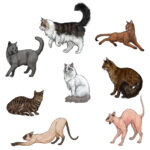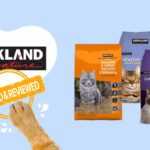The Norwegian Forest Cat, often affectionately called “Wegie,” is a majestic breed known for its sturdy build, distinctive double coat, and captivating wild appearance. Originating from the forests of Norway, this breed has evolved over centuries to withstand harsh climates, resulting in a robust and resilient feline companion. This comprehensive guide delves into the official breed standard of the Norwegian Forest Cat, providing an in-depth look at its physical characteristics, coat variations, colors, and essential traits that define this remarkable breed.
Understanding the Breed Standard
The breed standard serves as a blueprint, outlining the ideal characteristics of a Norwegian Forest Cat. It is used by cat registries and judges to evaluate cats in competitions and ensures the preservation of the breed’s unique traits. Norwegian Forest Cats are slow to mature, typically reaching their full size and grandeur around five years of age.
General Appearance
The Norwegian Forest Cat presents a powerful and balanced impression. They are sturdy cats with a long, muscular body and a substantial bone structure. Their most distinguishing feature is their double coat, designed to protect them from harsh weather conditions. The overall silhouette is that of a large, well-built cat with a wild, yet gentle expression.
Head
The head of the Norwegian Forest Cat is described as an equilateral triangle. Imagine drawing lines from the outer base of each ear to the point of the chin; all sides of this triangle should be of equal length. The neck is short, thick, and heavily muscled, adding to their robust appearance.
Nose Profile
A defining feature of the Norwegian Forest Cat is their straight nose profile. From the brow ridge to the tip of the nose, the line should be straight without any breaks or dips. The forehead is flat and transitions into a gently curved skull that flows smoothly into the neck.
Chin
The chin should be firm and strong, aligning vertically with the front of the nose. In profile, it appears gently rounded, contributing to the balanced triangular shape of the head.
Muzzle
The muzzle is an extension of the straight line from the base of the ear towards the nose. It should be well-defined but without pronounced whisker pads or a pinched appearance. This contributes to the overall triangular shape of the head and the breed’s distinctive look.
Ears
The ears of the Norwegian Forest Cat are medium to large, broad at the base, and taper to rounded tips. They are set as much on the sides of the head as on top, giving them an alert and open expression. The ear cup should point slightly sideways, and the outer lines of the ears follow the lines from the side of the head down to the chin. Heavy furnishing inside the ears is characteristic, and lynx tips (tufts of fur at the ear tips) are desirable but not mandatory.
Eyes
The eyes are large, almond-shaped, and expressive, conveying intelligence and alertness. They are set at a slight slant, with the outer corner positioned higher than the inner corner. Eye color should be clear and vibrant, in shades of green, gold, green-gold, or copper. White cats and cats with white markings may have blue or odd eyes (one blue and one of another color).
Body Structure
The body of the Norwegian Forest Cat is solidly muscled and well-balanced, exhibiting moderate length and substantial bone structure. They possess a powerful appearance, with a broad chest and considerable girth, yet they should not appear fat. The flank should be deep, adding to their overall substance. Males are typically larger and more imposing than females, who may be more refined in build.
Legs and Paws
Legs are medium in length with the hind legs being longer than the front legs, resulting in a rump that is higher than the shoulders. This conformation is not extreme but contributes to their agility and powerful gait. Thighs are heavily muscled, and lower legs are substantial. When viewed from the rear, the back legs should appear straight. From the front, the paws may appear to “toe out” slightly. Paws are large, round, and firm, with prominent tufting between the toes, aiding in traction, especially in snowy conditions.
Tail
The tail is long, bushy, and broad at the base, tapering slightly to the tip. Ideally, the tail length should be equal to the body length, measured from the base of the tail to the base of the neck. A full, flowing tail with guard hairs is highly desirable, adding to the breed’s balanced and impressive silhouette.
Coat Length and Texture
The coat is arguably the most iconic feature of the Norwegian Forest Cat. It is a distinguishing double coat, perfectly adapted for cold climates. It consists of a dense, woolly undercoat for insulation, covered by long, glossy, and smooth water-resistant guard hairs that hang down the sides of the body.
The bib, or frontal ruff, is a striking feature, particularly in males, and is composed of three sections: a short collar at the neck, side mutton chops framing the face, and a frontal ruff at the chest. Britches, or full, dense fur on the hind legs, further contribute to their cold-weather protection. The coat’s thickness varies seasonally, being fuller in winter when the dense undercoat is at its peak development, and somewhat lighter in summer. While a dense, water-resistant coat is paramount, softer coats are permissible in shaded, solid, and bicolor variations. Type and quality of the coat take precedence over color and pattern in judging.
Norwegian Forest Cat Colors and Patterns
A wide array of colors and patterns are accepted for the Norwegian Forest Cat, adding to the breed’s visual diversity. The only colors and patterns that are not permissible are those indicative of hybridization, such as chocolate, sable, lavender, lilac, cinnamon, fawn, and point-restricted patterns (like Siamese or Himalayan markings), or these colors combined with white.
Eye Color
Eye color should complement the coat color and can range through shades of green, gold, green-gold, and copper. White Norwegian Forest Cats and those with white markings are exceptions and may have blue or odd eyes.
Nose Leather and Paw Pads
Nose leather and paw pad colors can vary widely and are not necessarily correlated with coat color, except in specific color variations. Cats with white on their feet may have pink paw pads or a combination of colors.
Buttons and Lockets
Small white markings such as buttons (small spots of white on the chest or abdomen) and lockets (small patches of white on the neck or throat) are permissible in all colors and patterns. Cats with buttons or lockets are judged based on their primary color, without penalty for these white markings.
Color Variations
The breed standard details specific color descriptions, including:
- White: Pure, glistening white.
- Black: Dense, coal black from roots to tips.
- Blue: A uniform, level blue tone from nose to tail.
- Red: A deep, rich, clear, brilliant red without shading or markings.
- Cream: A uniform shade of buff cream, lighter shades preferred.
- Silver and Golden Chinchilla & Shaded: Variations with white or cream undercoats and black tipping creating a sparkling silver or golden appearance.
- Cameo (Red Chinchilla & Shaded): White undercoat with red tipping creating a sparkling red appearance.
- Tortoiseshell: Black with patches of red and cream.
- Smoke: White undercoat deeply tipped with color (black, blue, cream, red), appearing solid in repose but revealing the white undercoat in motion.
- Tabby Patterns (Classic, Mackerel, Spotted, Ticked): Various tabby patterns in brown, blue, silver, red, cream, and cameo variations.
- Patched Tabby: Tabby patterns with patches of red and/or cream.
- Calico & Dilute Calico: White with patches of black and red (calico) or blue and cream (dilute calico).
- Bi-Color & Van Bi-Color: White with patches of another solid color.
- Van Calico & Van Dilute Calico: Van pattern (color restricted to extremities) in calico and dilute calico.
- Amber & Light Amber: Recessive yellow colors ranging from dark honey-chestnut to pale beige blonde, sometimes with ghost tabby markings.
This extensive color palette ensures a wide variety within the Norwegian Forest Cat breed, each as striking and beautiful as the next.
Disqualifications
Certain traits are considered disqualifications in Norwegian Forest Cats, as they deviate significantly from the breed standard or indicate potential health or genetic issues. Disqualifications include:
- Severe break in the nose profile.
- Square muzzle.
- Whisker pinch (a narrowing of the muzzle).
- Long, rectangular body.
- Cobby body (short and stocky).
- Incorrect number of toes.
- Crossed eyes.
- Kinked or abnormal tail.
- Delicate bone structure.
- Malocclusion resulting in undershot or overshot chin.
- Colors indicating hybridization (chocolate, sable, lavender, lilac, cinnamon, fawn, point-restricted patterns).
Temperament and Personality
Beyond their striking physical attributes, Norwegian Forest Cats are renowned for their gentle and friendly temperament. They are affectionate and enjoy being around their families, but they are not overly demanding or clingy. They are intelligent and adaptable cats, known for being good with children and other pets, making them excellent family companions. Their independent nature means they are also comfortable spending time alone. They are playful and enjoy interactive toys and activities, retaining a kitten-like spirit well into adulthood.
Grooming and Care
Despite their long, dense coat, Norwegian Forest Cats are relatively easy to groom. Regular brushing, especially during shedding seasons (spring and fall), is essential to prevent matting and tangles and to remove loose fur. Bathing is rarely necessary unless the cat gets particularly dirty. Regular nail trimming and ear cleaning are also part of routine care. Providing a balanced, high-quality diet and ensuring access to fresh water are crucial for maintaining their overall health and coat condition.
Health Considerations
Norwegian Forest Cats are generally a healthy breed, but like all breeds, they can be prone to certain health issues. Hypertrophic cardiomyopathy (HCM), a heart condition, and hip dysplasia are conditions that have been observed in the breed. Responsible breeders screen their cats for these conditions to minimize their occurrence. Regular veterinary check-ups are essential for preventative care and early detection of any health concerns.
Conclusion
The Norwegian Forest Cat is a breed of captivating beauty and gentle nature. Their robust build, magnificent double coat, and wide array of colors make them visually stunning, while their affectionate and adaptable temperament makes them wonderful companions. Understanding the breed standard provides valuable insight into the ideal characteristics of this breed, but ultimately, the joy of owning a Norwegian Forest Cat lies in their unique personality and the loving bond they form with their families. Whether you are considering showing, breeding, or simply welcoming a Wegie into your home, you are sure to be enchanted by this remarkable feline.


